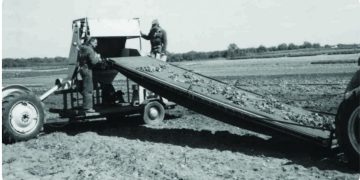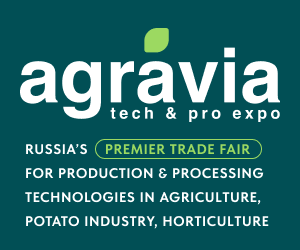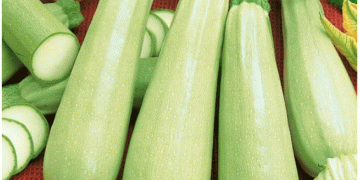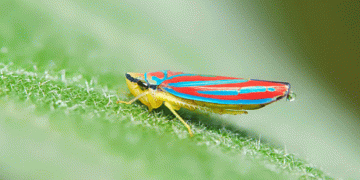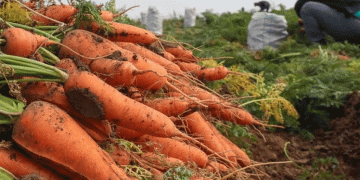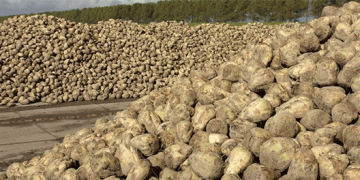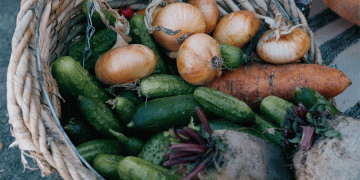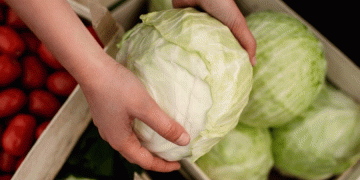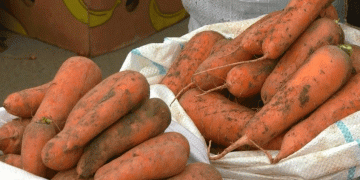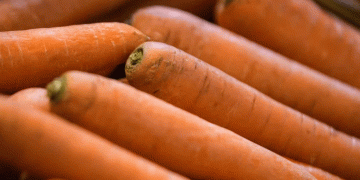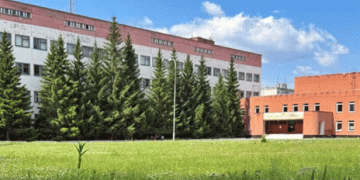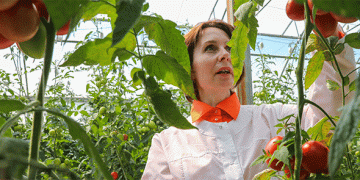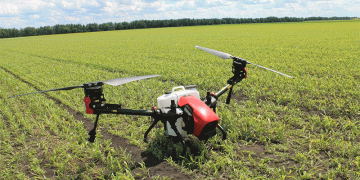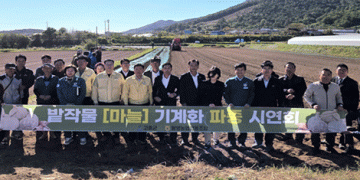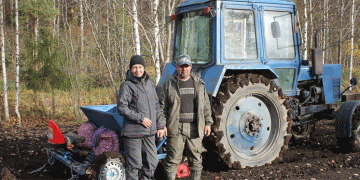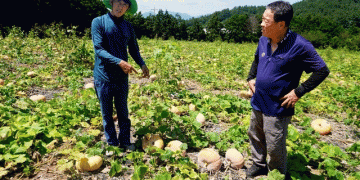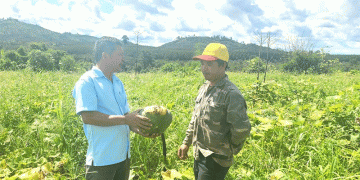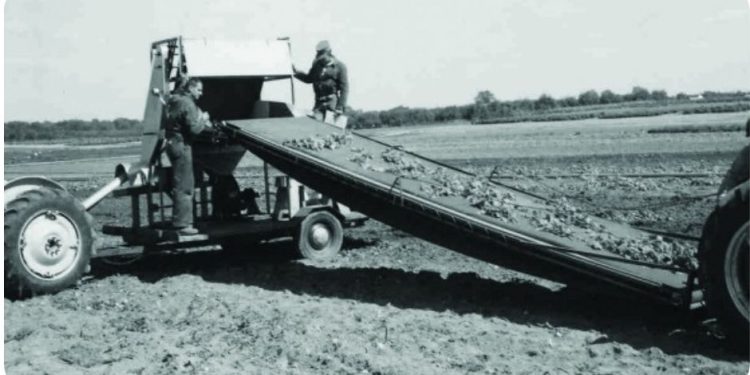He’s worked on equipment that has fed farm animals, harvested vegetables, swept citrus off the ground and aided in poultry processing – and that’s only a partial list. Through all those projects during his career as an agricultural engineer, Dale Marshall put into practice two indispensable strategies: observation and adaptation.

Those practices put him in tune with his grower constituency, made up of people who operate the same way.
“That’s how farmers and processors are so innovative. They say ‘let’s just make that a half-inch longer’ or ‘let’s speed that up a bit.’ That’s how they make improvements on their own,” Marshall said.
Marshall, 81, who now lives in Holt, Michigan, with wife Pat, spent the bulk of his career as a an engineer with USDA’s Agricultural Research Service, based on campus at Michigan State University. While at MSU, Marshall worked primarily on vegetable projects, and occasionally collaborated on fruit projects.
The practice of adaptation started early, as a senior ag engineering student at MSU in 1960, when Marshall helped faculty member Bill Stout convert a potato digger into a tomato harvester. An old sugar beet harvester was the genesis for a commercial pepper harvester. That machine was donated to MSU, but often enough the adaptation began with traveling to observe another machine in action.
“I got in a car with Dr. Burton Cargill and we drove to Vincennes, Indiana. That’s where I saw my first mechanical cucumber harvester, a Wilde made in Bailey, Michigan. Then we continued for all of 1969, and for many years after that doing mechanical cucumber harvesting research, not so much to improve the harvesting aspect but in trying to reduce the bruising and breakage of harvested fruits as it moved through the machine,” Marshall said.
Perhaps the biggest breakthrough came in the development of a mechanical pepper harvester.

“We had growers who told us that they either had to mechanize or not be able to continue to grow peppers,” Marshall said.
That resulted in another trip to see a harvester, this time a flight to Delaware. Marshall saw that the machine had potential, but also concluded that not enough of the peppers were getting through. This meant it was time for another one of those adaptations that makes an engineer’s day, if not career.
“Not more than 5 to 10 percent of the peppers were getting inside. But I knew that if I were to make a little pointed auger, maybe a foot long, with a helix around the point, this would nudge the peppers up and bring them into the harvester itself. So we started building the harvester when I got back to MSU,” Marshall said.
That’s where the sugar beet harvester entered the picture. The machine was donated by the sugar beet industry to MSU and USDA for research.
“We chopped and cut and welded and extended to make the harvester,” Marshall said.
Once the prototype was done, it was time for field trials. Marshall distributed pepper seed and, in 1987, established five plantings. Two were in Michigan and the others were in Kentucky, Oklahoma and California, to compare 20 different types of peppers and 15 different harvesting setups. Those comparisons and conclusions were crucial in building what became the Boese harvester.
Cooperation from the industry, growers and fellow researchers consistently helped the research projects make progress, Marshall said. Colleagues included USDA research leaders and fellow ag engineers Galen Brown and Leroy Pickett; MSU faculty members Hugh Price, Bernie Zandstra and Randy Beaudry; pickle industry leaders Bill Temple and Jack Hobson; and research technicians such as Ed Timm, Dick Ledebuhr, Dick Wolthuis and Gary VanEe.
Marshall put a lot of his own students to work, and later saw them become key players in the produce industry.
“In my 28 years at MSU, I hired 85 students, and boy did they get the experience,” Marshall said.
Marshall grew up on a farm in Livingston County, Michigan, and picked up his mechanical aptitude largely by watching his father, who Marshall described as an “early adapter of anything new. If we could do it with machines, we’d go for it.”
In 1953, Marshall completed an eight-week short course at MSU, which laid the groundwork for a later engineering degree in 1960. One of his major projects was working with Stout on the tomato harvester adapted from a potato digger.
His first job was in Minnesota, working for Farmhand on farm-lot equipment, including self-unloading wagon boxes. The next stop was Indiana for Chore Time, specializing in poultry feeding and watering equipment.
Marshall joined USDA in 1966, and his first assignment was in Florida to begin working with mechanically harvested citrus. The top priority was to come up with a way to pick up fruit that had already been removed by hand or mechanical shakers during times, such as weekends, when workers were not readily available.
“My job was to develop a sweeper harvester that would sweep the furit out from underneath the overhanging tree branches, put it in the row middle and then pick it up. We used metal drums two feet in diameter that had six-inch long rubber fingers to sweep the fruit with the three-foot-diameter auger. Then, because of Florida’s sandy soil, it was easy to come alongside with a potato digger and chain to pick up the fruit,” Marshall said.
Marshall’s long career at MSU was interrupted when he was involved in a nearly fatal automobile accident. USDA then decided to shutter the vegetable project based at MSU, and Marshall concluded his career by moving to Georgia to work on evisceration of broiler poultry. That project lasted 20 months, and then Marshall retired in 1999. The Marshalls stayed in Georgia for 10 years before returning to Michigan.
Among the ornamentals planted outside their home in Holt are two rhubarb plants, reflecting Marshall’s lifelong interest and work with the vegetable. In the late 1970s, the rhubarb industry requested help with a mechanical harvester, and Marshall started reworking an experimental machine donated by the pickle industry. Marshall and his team successfully developed a machine that would sever the rhubarb petioles with the leaves attached. A cut-of disk would remove the leaves, while the petioles would drop into a bin. Wilde eventually manufactured a harvester and got it ready to ship to a Michigan grower for a fall picking.
“And then the grower quit growing rhubarb, because he found something much more profitable on his land: oil,” Marshall said. “So that settled it. Three more harvesters were built, but none are now being used.”
Having grown up on a crop and livestock farm, working with fruits and vegetables was a new and interesting challenge.
“If we had an idea, we’d try and see if the crop survived our research. People said, ‘oh, you’re working on crop improvement.’ I’d say no, it was more trying to maintain the inherent crop quality, trying to reduce product breakage, abrasion and bruising.” Marshall said. “Looking for innovative harvesting and handling methods along with university, industry, processors, farmers and students was the key to our success. Visiting foreign researchers was also valuable. It was been a joy to work with the personnel in the fruit and vegetable industry.”
Marshall’s career dovetailed with the origins of The Vegetable Growers News.
“In the early years of The Vegetable Growers News, it was common for Barry Brand, founding publisher, to call me at 9 or 10 p.m. to read me his story that was going to press the next day, to insure he had all the facts correct,” Marshall said.
— Lee Dean, editorial director
